This post may contain affiliate links. Please read our disclosure policy.
How to make mango sago; a sweet, creamy, and refreshing summery dessert that combines fresh mango with creamy coconut milk, decadent condensed milk, and sago pearls. Even better, this sago dessert is gluten-free, can be made dairy-free (vegan), and requires just 4 ingredients!
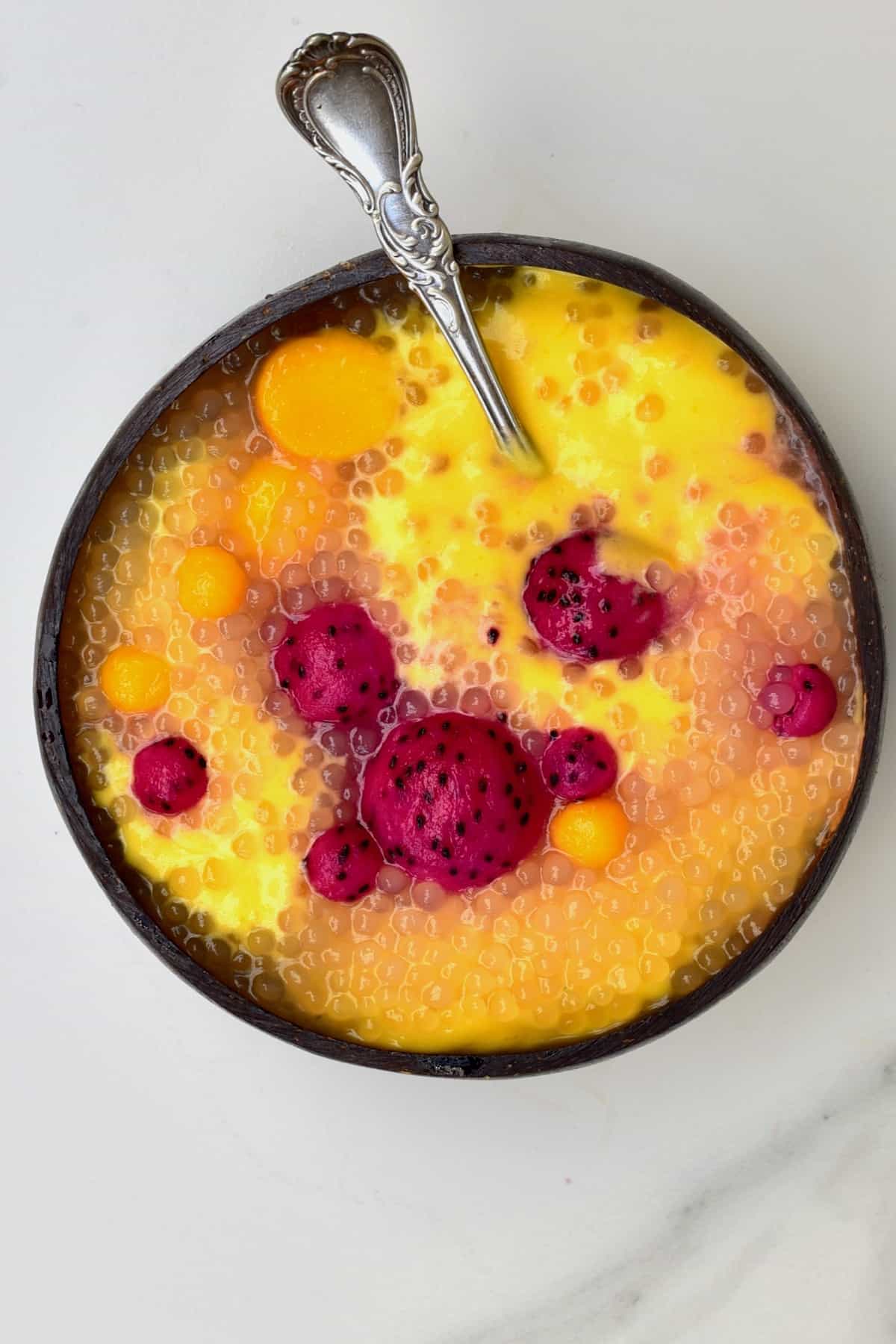
Having recently spent time making mango boba – aka tapioca pearls – and previously, plain tapioca pearls, I came across this mango sago dessert idea. I knew I had to try it for myself and absolutely loved the creamy, rich, sweet, chewy results of this mango sago!
This mango sago recipe is sweet and tropical, packed with flavor and texture, and is simple to prepare. Even better, it takes under an hour to make (under 30 minutes, if you’ve soaked the pearls!) and can be enjoyed with dairy or dairy-free milk. By making the sago with coconut milk, all you need to do is swap out the condensed milk for coconut condensed milk, based on whether you want it vegan or not.
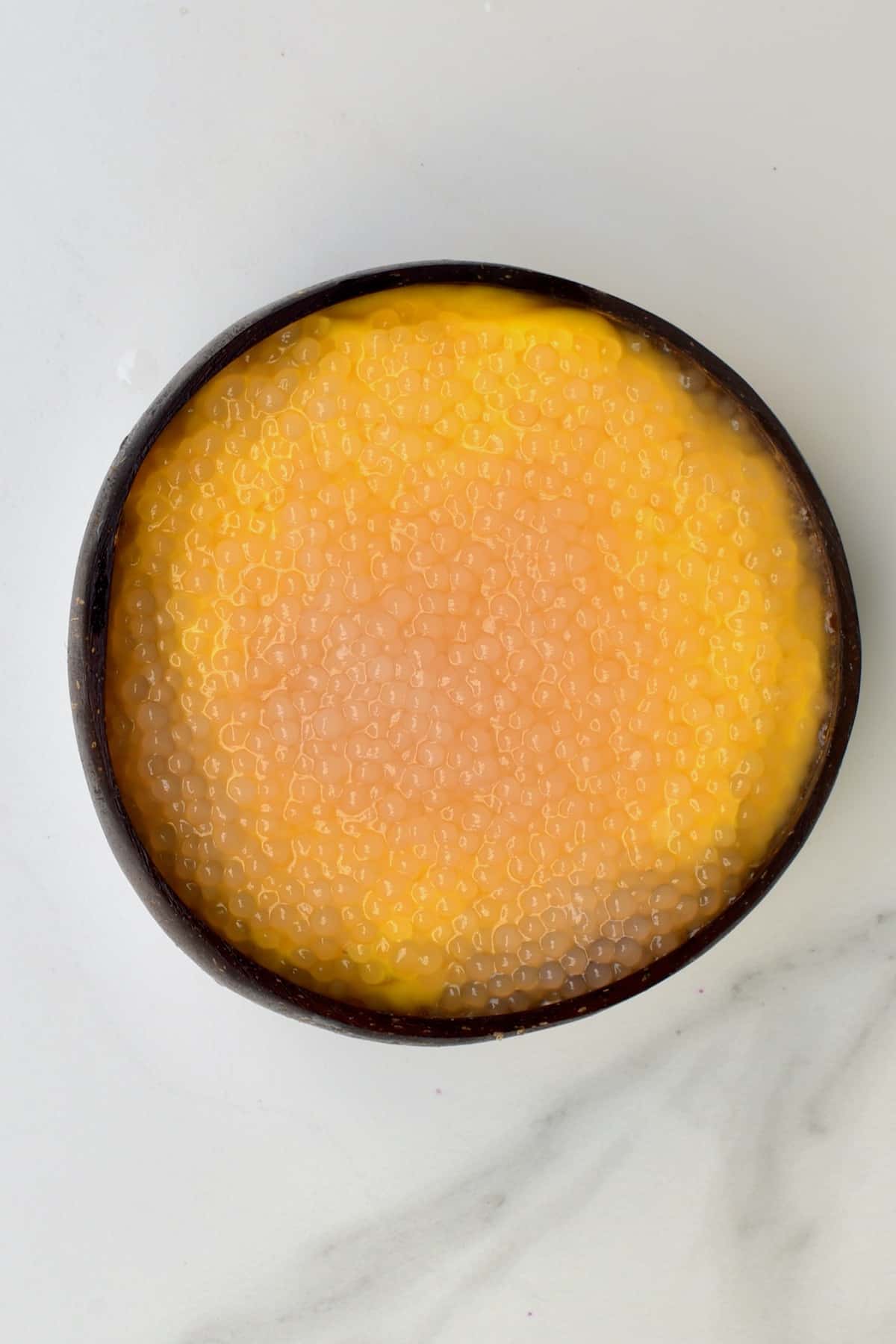
I’ll admit, this recipe is best enjoyed during the mango season when the fruit is at its ripest and juiciest. However, I sometimes get a little impatient (like now!). In fact, I went a little crazy and bought a few too many – which means, along with this mango sago dessert, I’ll also be whipping up more mango lassi this week and probably a mango smoothie or overnight oats, because yummy!
Want to save this recipe?
What is Sago and Sago Pudding?
Sago is a starch found in several tropical palm stems, particularly ‘Metroxylon Sagu’ (aka sago palms). Once extracted from the plants, it is used for many cooking purposes, including thickening liquids (like other starches), making pancakes, or rolling into tiny ‘pearls,’ similar to tapioca.
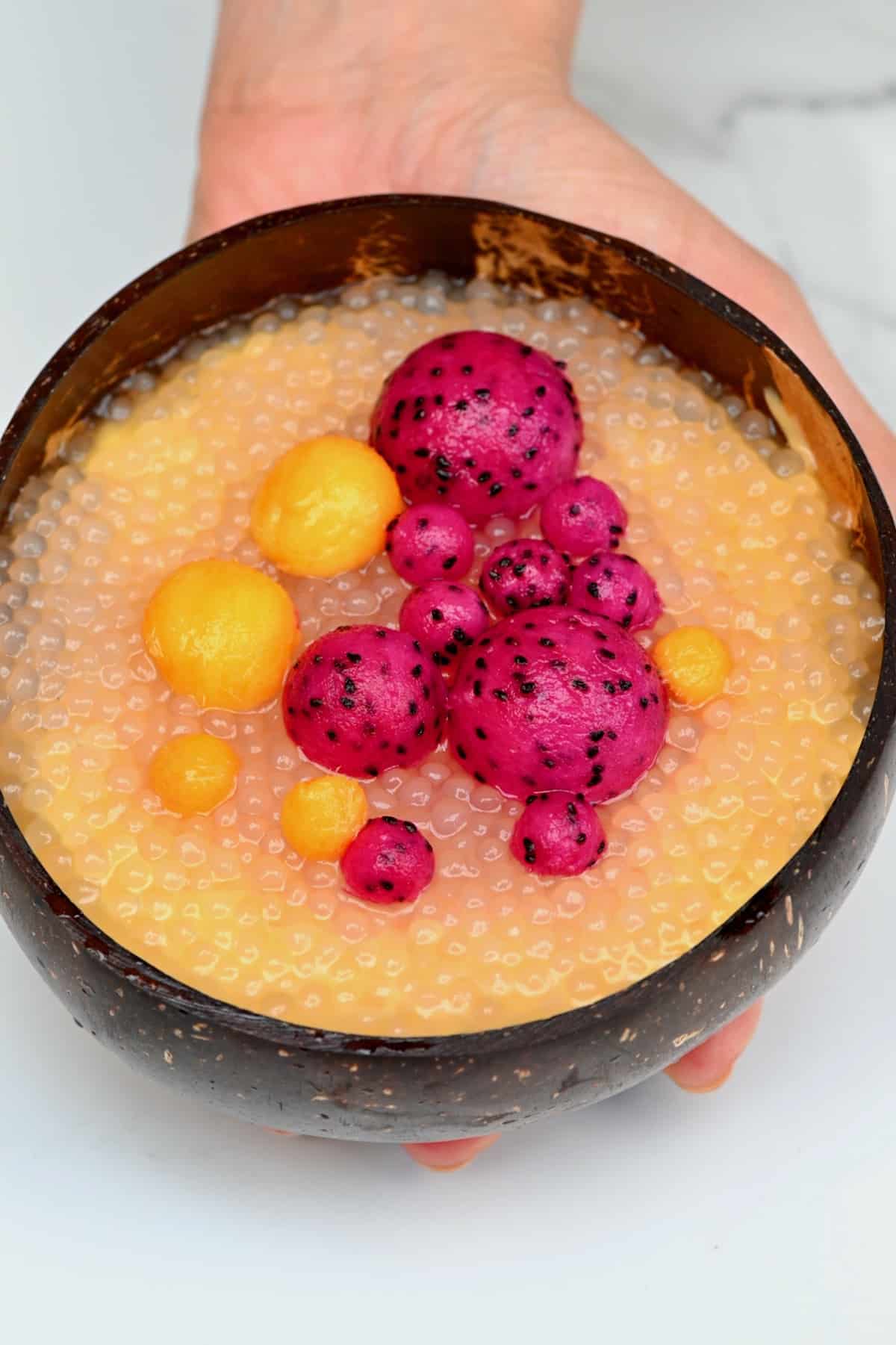
Sago pudding is traditionally made by boiling the pearls with water or milk and sugar into a sago dessert that’s either fairly runny or thick (similar to rice pudding) and has the nickname ‘frogspawn’ due to the look of the tiny pearls. However, there are also several flavored versions, including this mango sago, which combines the pearls with fresh mango for a sweet, fresh treat.
The Ingredients
- Mango: make sure to pick fresh, ripe mango for the best flavor. You could also use a high-quality tinned mango pulp (like Alphonso mango or Thai mango). The mango you use will directly impact the sweetness of the dish.
- Sago pearls: I used tiny sago pearls. However, feel free to use medium ones if you prefer more chew.
- Coconut milk: I used full-fat coconut milk for the best flavor and results. You could try it with a lite version, though the sago dessert won’t be as creamy.
- Condensed milk: you can use regular condensed milk or coconut condensed milk, based on whether you want to prepare this mango sago recipe as dairy-free. If you want to adapt the amount of sugar you use, you could use evaporated milk and the sweetener of your choice (liquid or granulated).
- Dragonfruit (optional): I used pink dragonfruit as an extra tropical topping. However, it’s 100% optional. You could simply save some of the mango chunks for a topping, instead.
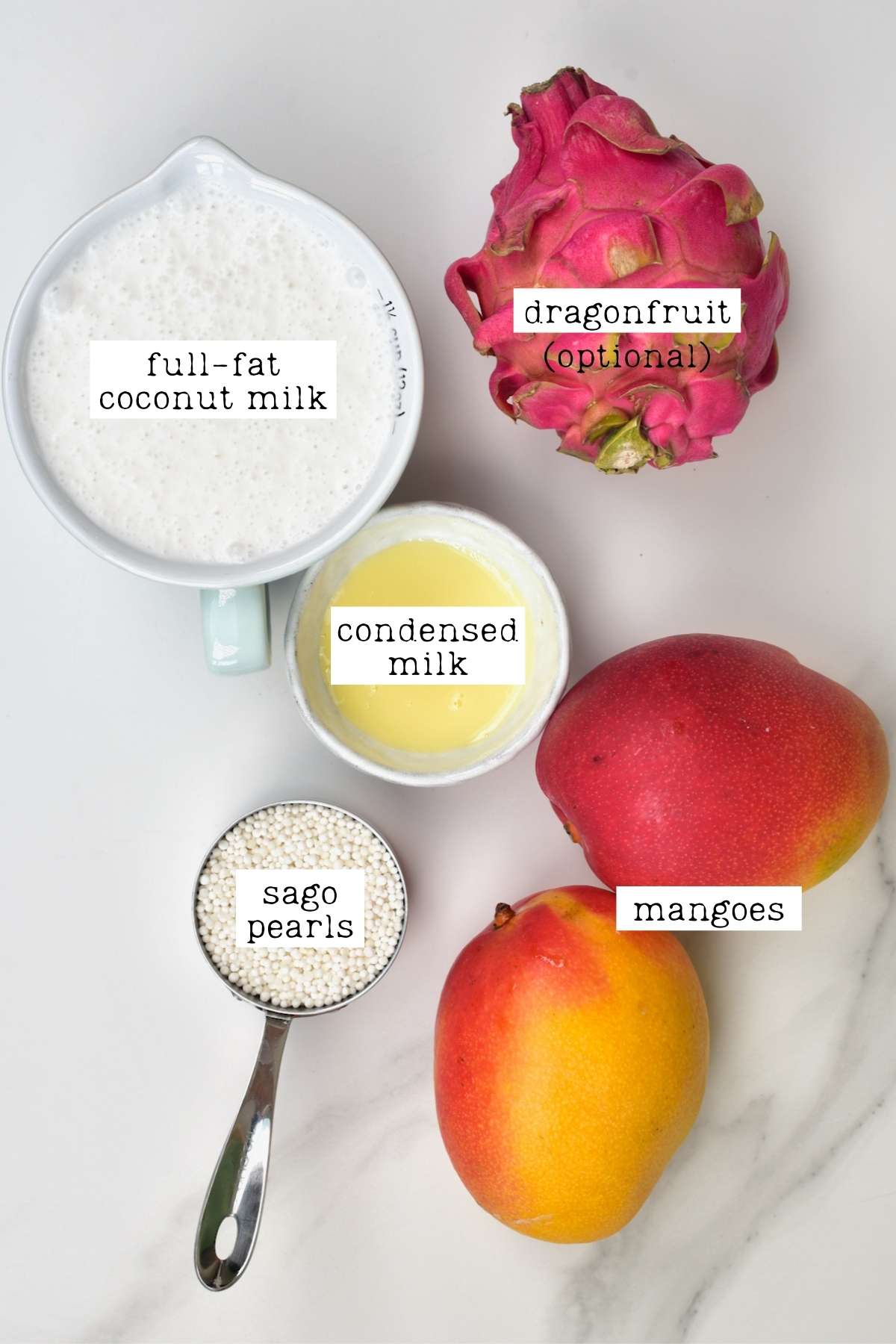
Other Optional Add-ins and Variations
- Mango pomelo sago: the original Hong Kong version of this dish included pomelo. If you live somewhere where it’s easy to source this ingredient, it’s highly recommended – it adds citrusy tang to the dessert. You can add pomelo segments or peel the skin off the segments and separate the tiny ‘pulp’ sections inside for a citrusy treat that bursts in your mouth. If you can’t find pomelo, you could try another tart citrus, like grapefruit.
- Coconut: shredded or flakes, you can add coconut to the top of the pudding. I recommend toasting it for a slight crunch and an extra layer of flavor.
- Lime: for a touch of ‘zing’ and extra freshness, you could serve the mango sago dessert with a squeeze of fresh lime.
- Vanilla Extract: feel free to add a little vanilla extract to the mango blended mixture for extra flavor. I use homemade vanilla extract and add around ½ tsp then increase, to taste.
How to Make Mango Sago Pudding
Step 1: Soak the pearls
Technically this step is optional but highly recommended as it can cut their cooking time down by 50%! I recommend soaking the pearls in room-temp water for at least two hours at room temperature or overnight (in the fridge).
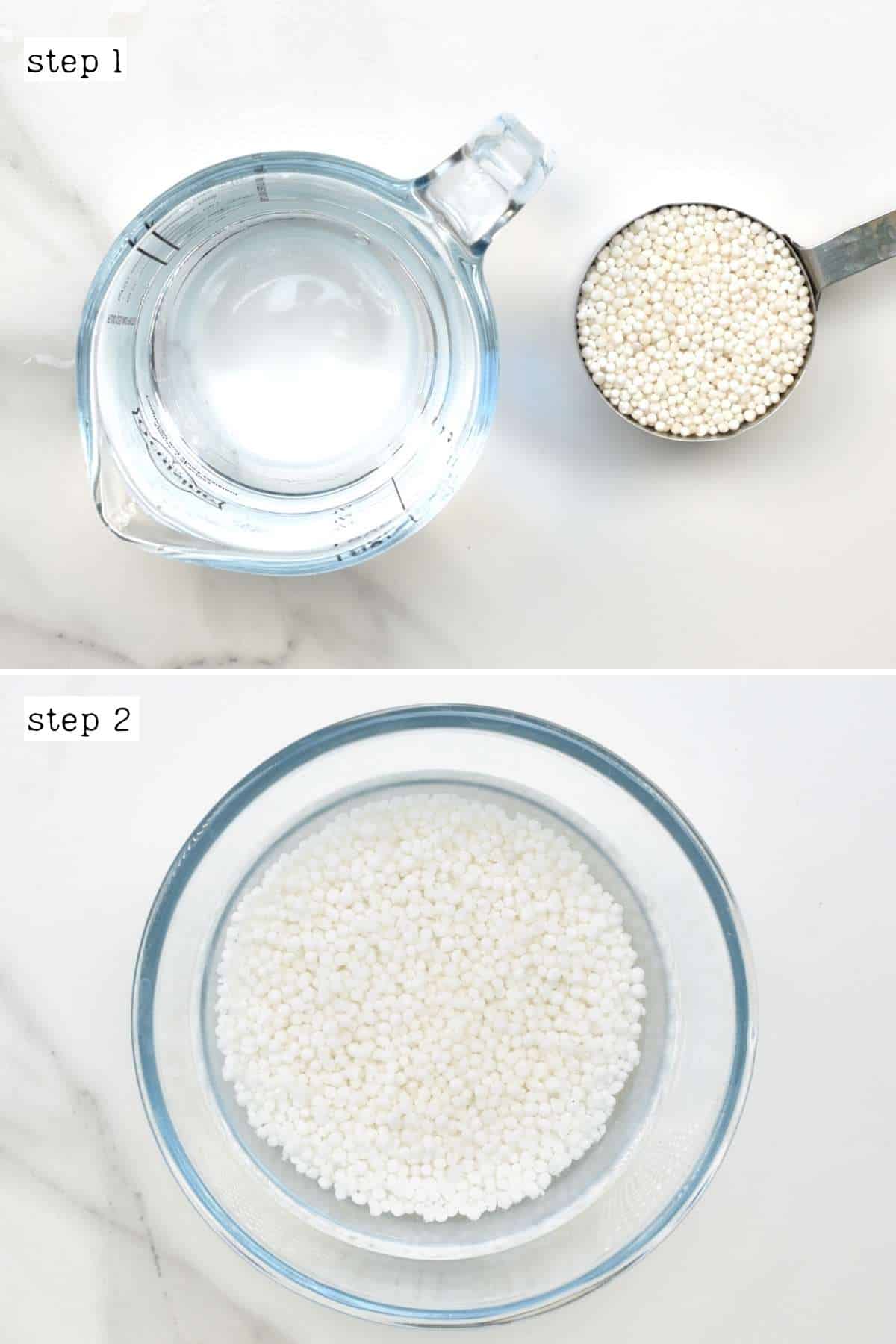
Step 2: How to cook sago pearls
Bring a pot of water (enough to cover the pearls by several inches as they’ll expand 2-3x their size while cooking) to a boil.
Then, add the sago pearls, bring to a boil once more, and then reduce the heat to a simmer and cook until the pearls are completely translucent, with a slightly brownish tint.
This will take around 40-45 minutes if the pearls weren’t soaked or 15-20 if they were.
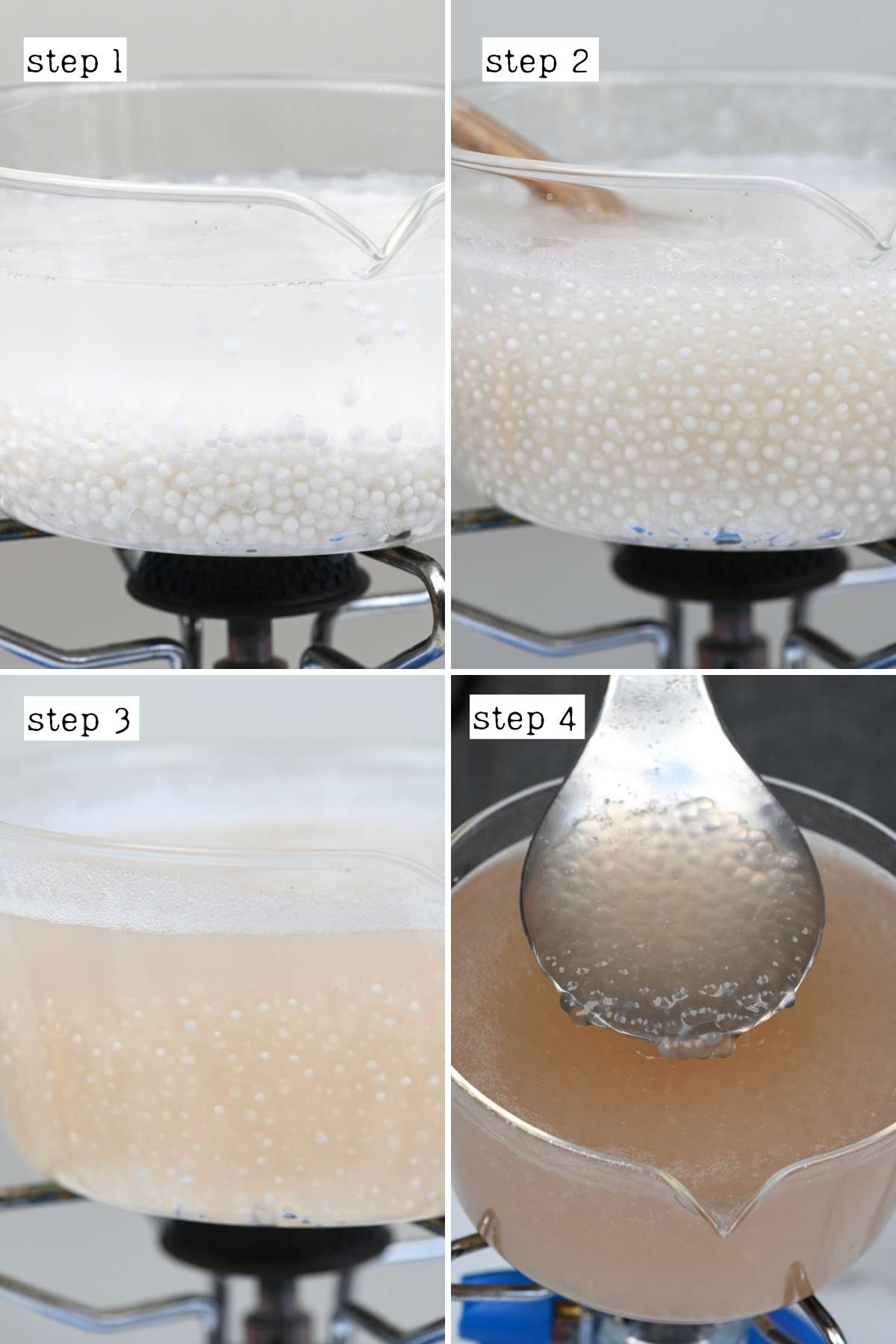
Step 3: Drain and rinse the sago
First, drain the sago pearls through a colander and then rinse them well with cold water to remove excess starch.
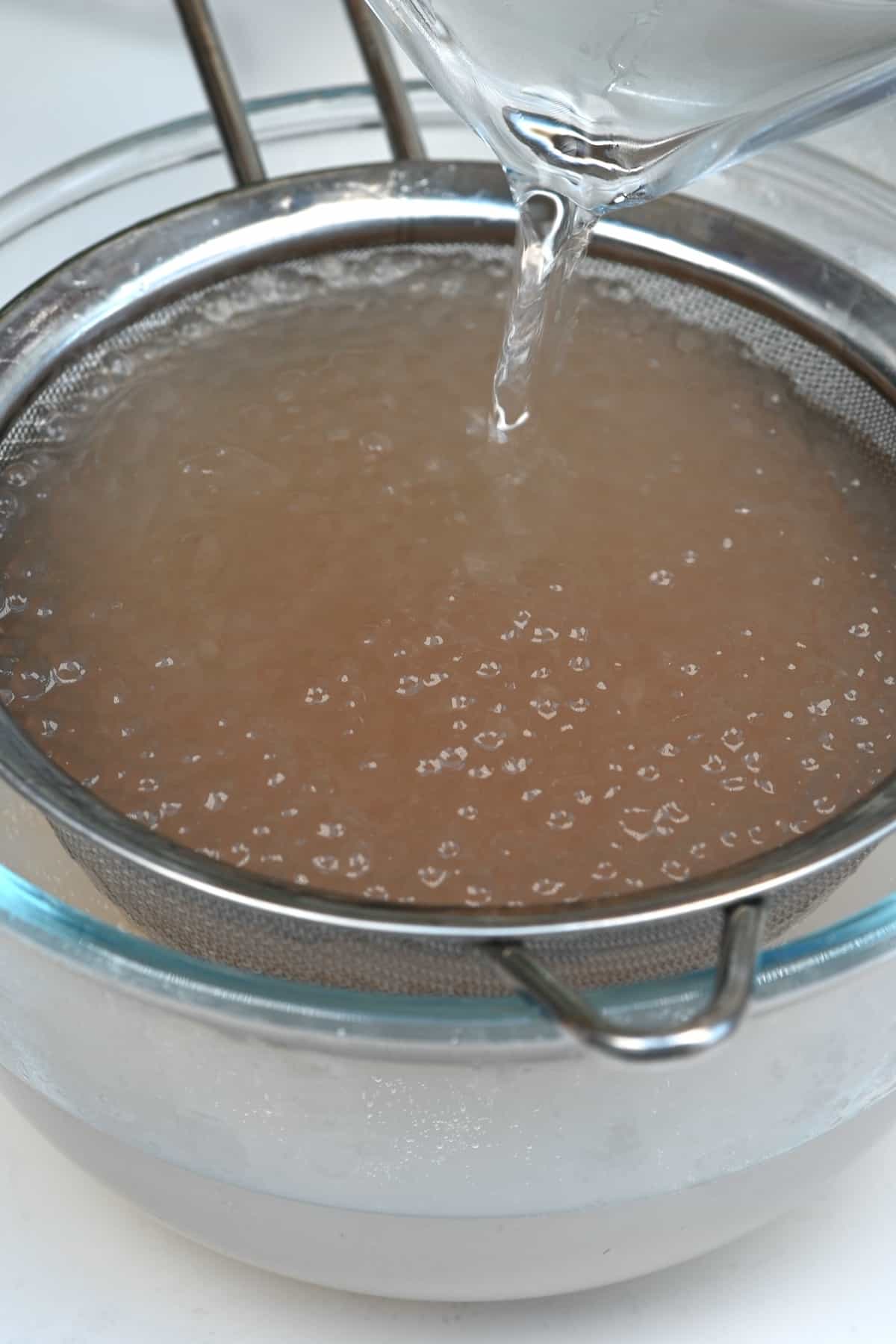
If the remainder of the mango sago pudding ingredients aren’t prepared at this point (it only takes a couple of minutes), then you can keep the sago in cold/ice water while prepping them.
Don’t leave cooked sago balls out at room temperature for more than 4 hours, or they can turn bad. If you know you won’t be using them for longer, then store them, in the water, in the refrigerator.
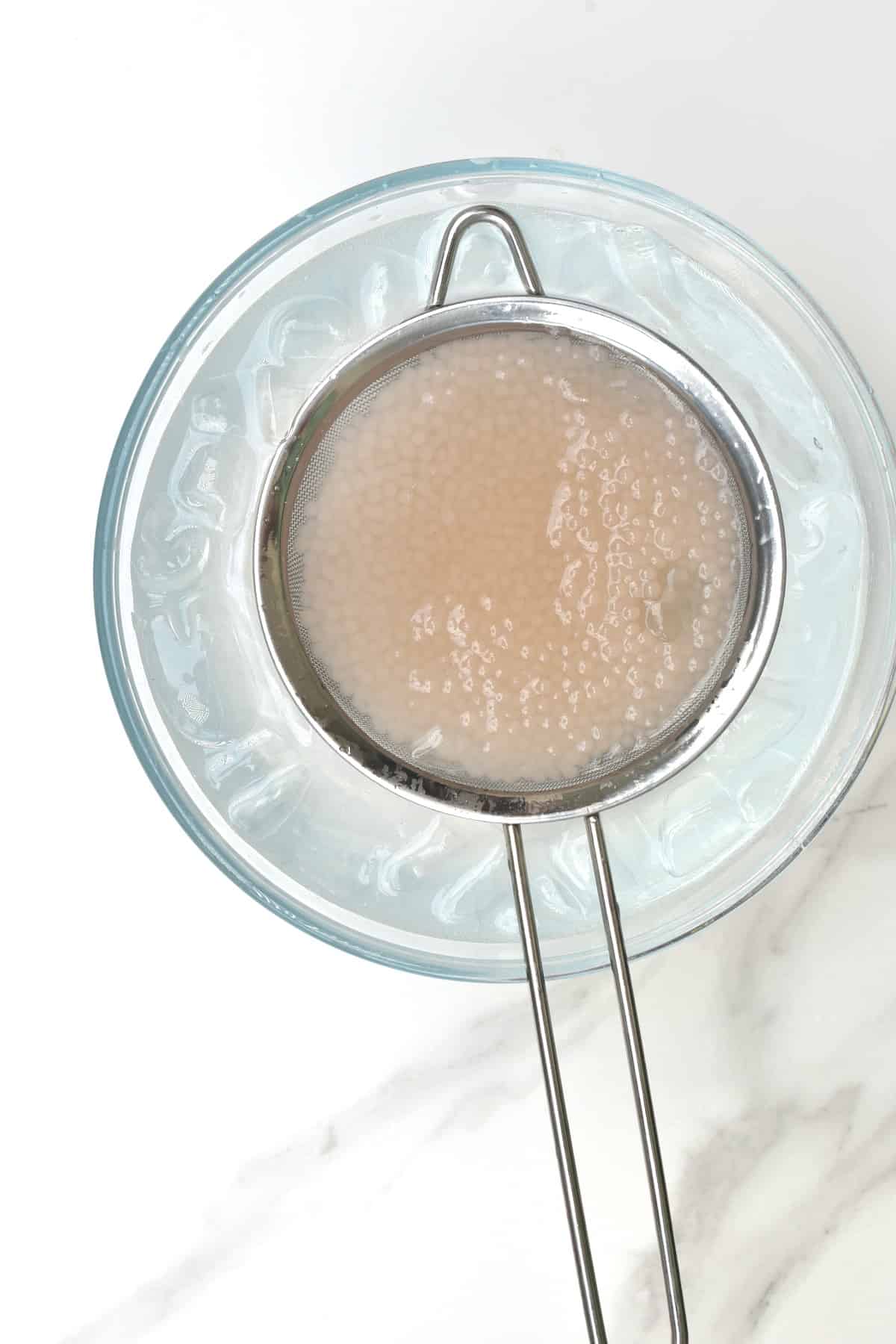
Step 4: Prepare the mango pudding
First, cut the mango (using one of these four methods). As you will blend the mango, there’s no need to make pretty cubes. You could even peel the mango and simply scoop all the flesh from the seed.
Feel free to keep some to one side as a topping. I used a mini scooper/baller to create little mango ‘balls’. I did the same with some pink dragon fruit.
Add the mango, coconut milk and condensed milk to your food processor or blender and blend till you achieve a smooth consistency.
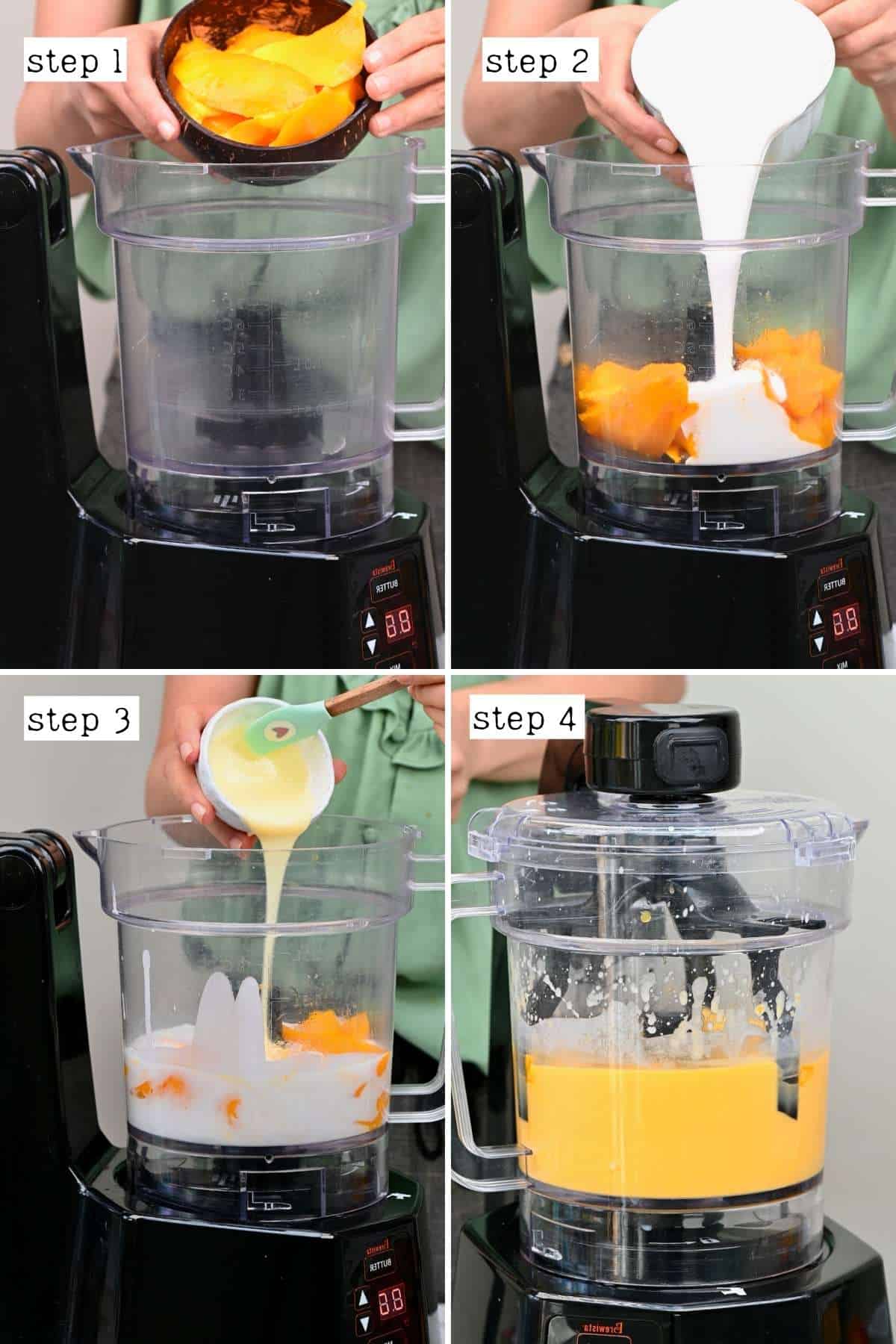
If the pudding is too thick, then add in a little more milk. If it’s not sweet enough, increase the condensed milk or add a little of your favorite liquid sweetener (like maple).
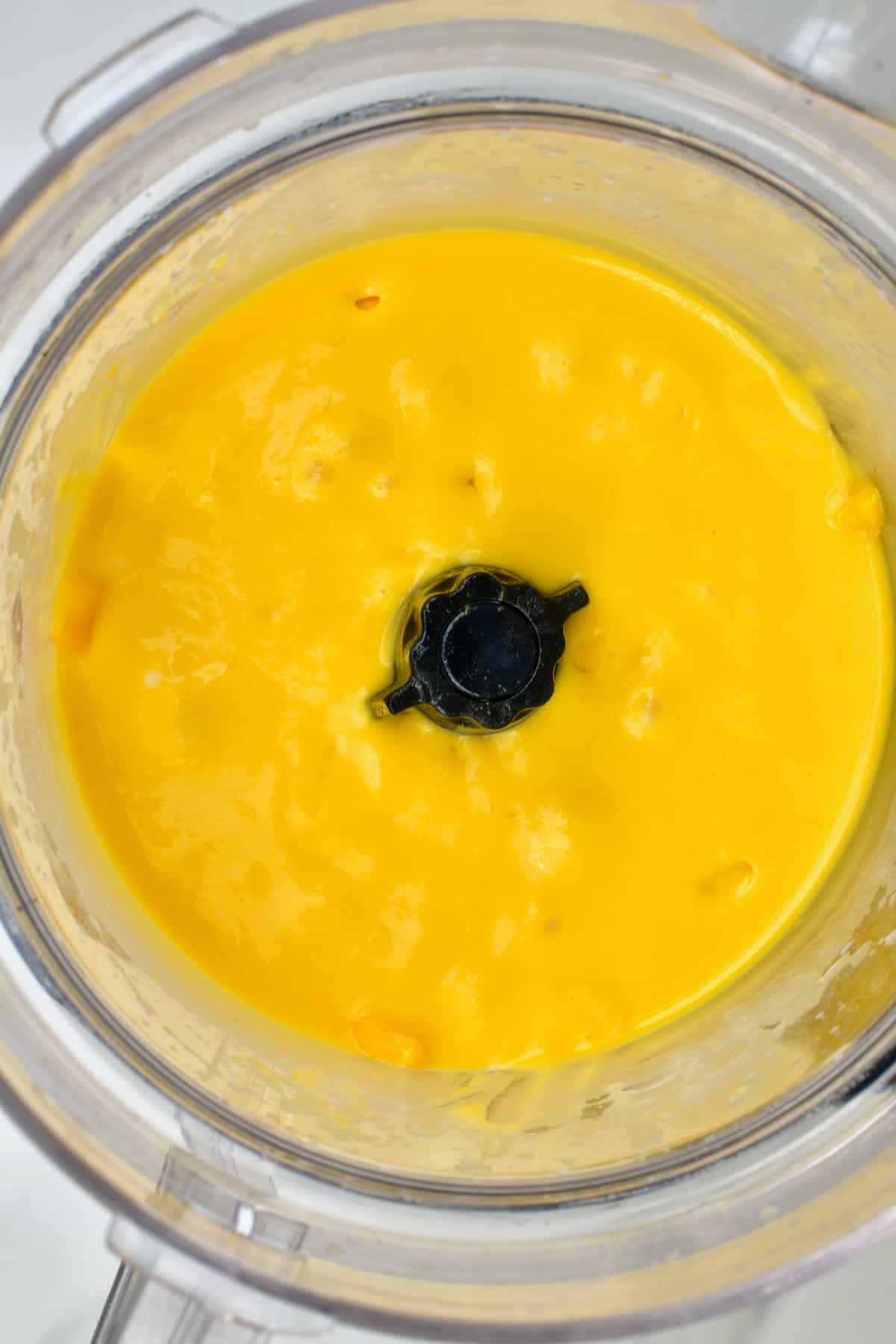
I also decided to make some dragonfruit pearls as the mango sago decoration. This step is completely optional.
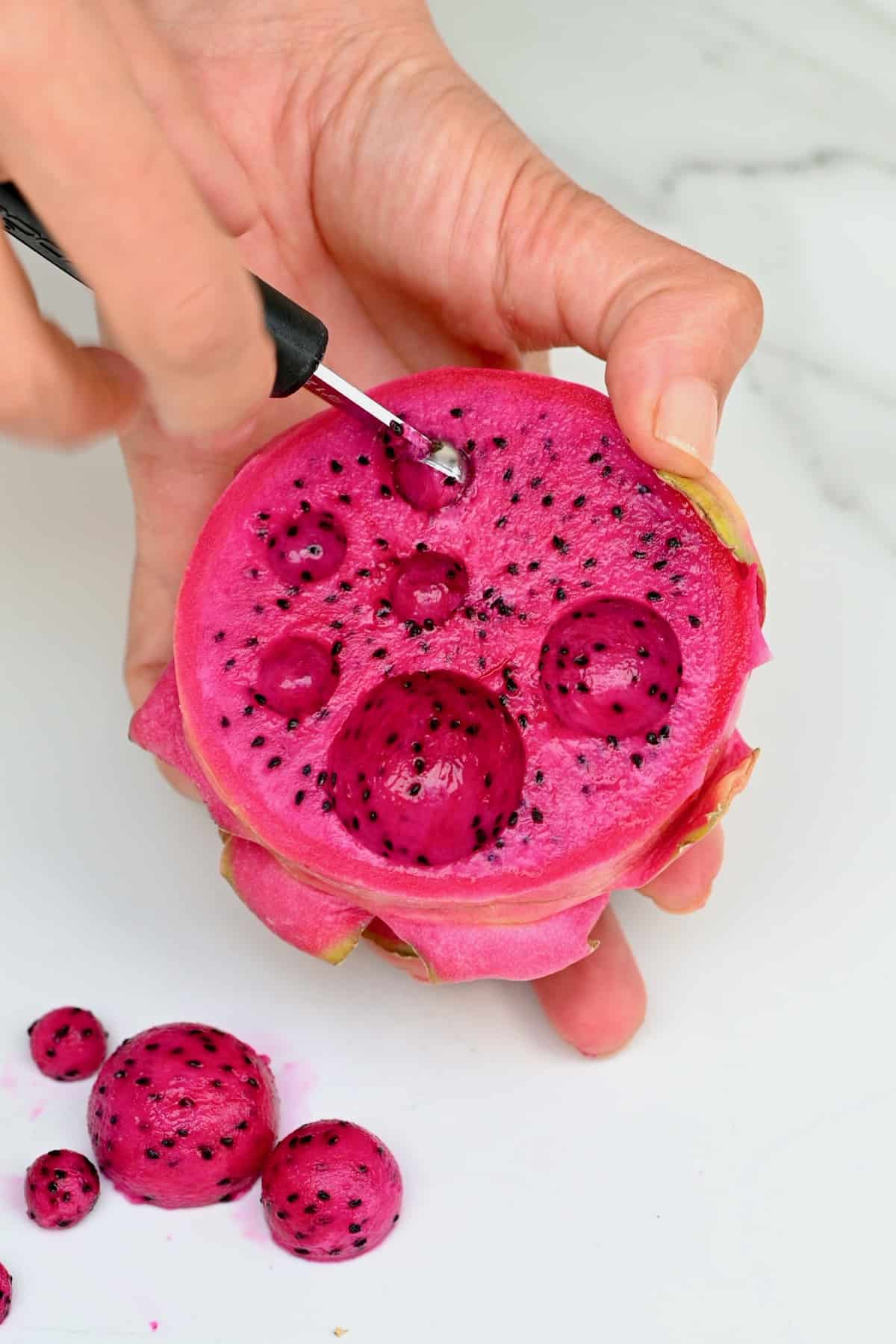
Step 5: Assemble the mango sago bowls
Transfer the mango mixture to a bowl (or glass jars/cups) and add the sago pearls. These can be used to top the pudding or mixed into it, then top with the mango and dragonfruit balls (and optionally some shredded/flaked coconut). You could also add a few extra spoonfuls of coconut milk if preferred.
For extra sweetness, you could even drizzle the top of the pudding with a bit of extra condensed milk.
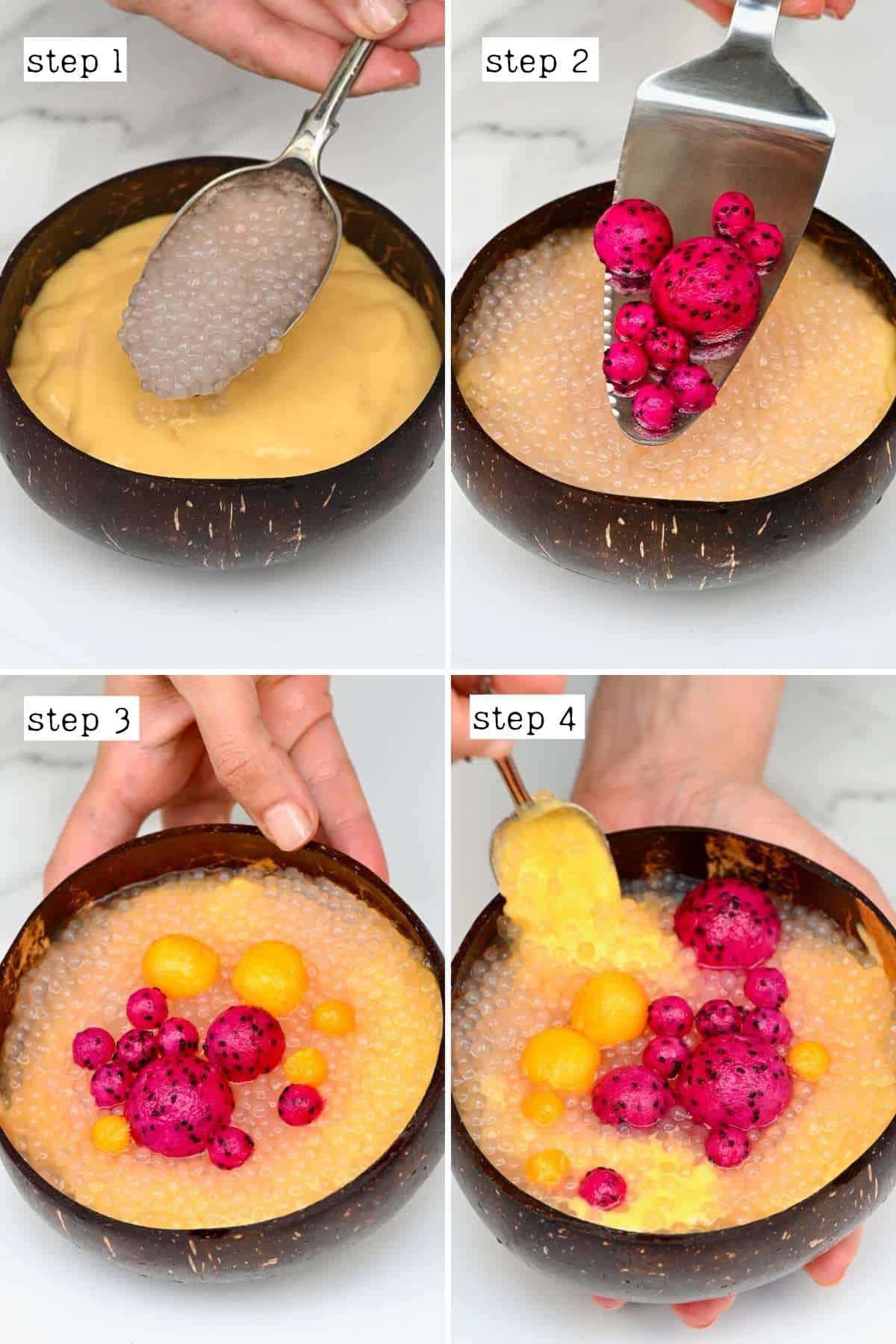
How to Store Mango Sago?
Store: Store the prepared mango sago in the fridge for up to two days, though the fresher it is, the better the results. To read about how to store the cooked sago pearls, read the FAQs below.
Freeze: I haven’t tried to freeze this sago dessert before as I prefer it fresh. However, freezing the prepared, combined mango sago should work (untopped). I recommend wrapping it tightly (or transferring it to single-serve airtight containers) then freeze for up to three months. Allow it to thaw overnight for an ‘instant’ dessert the following day.
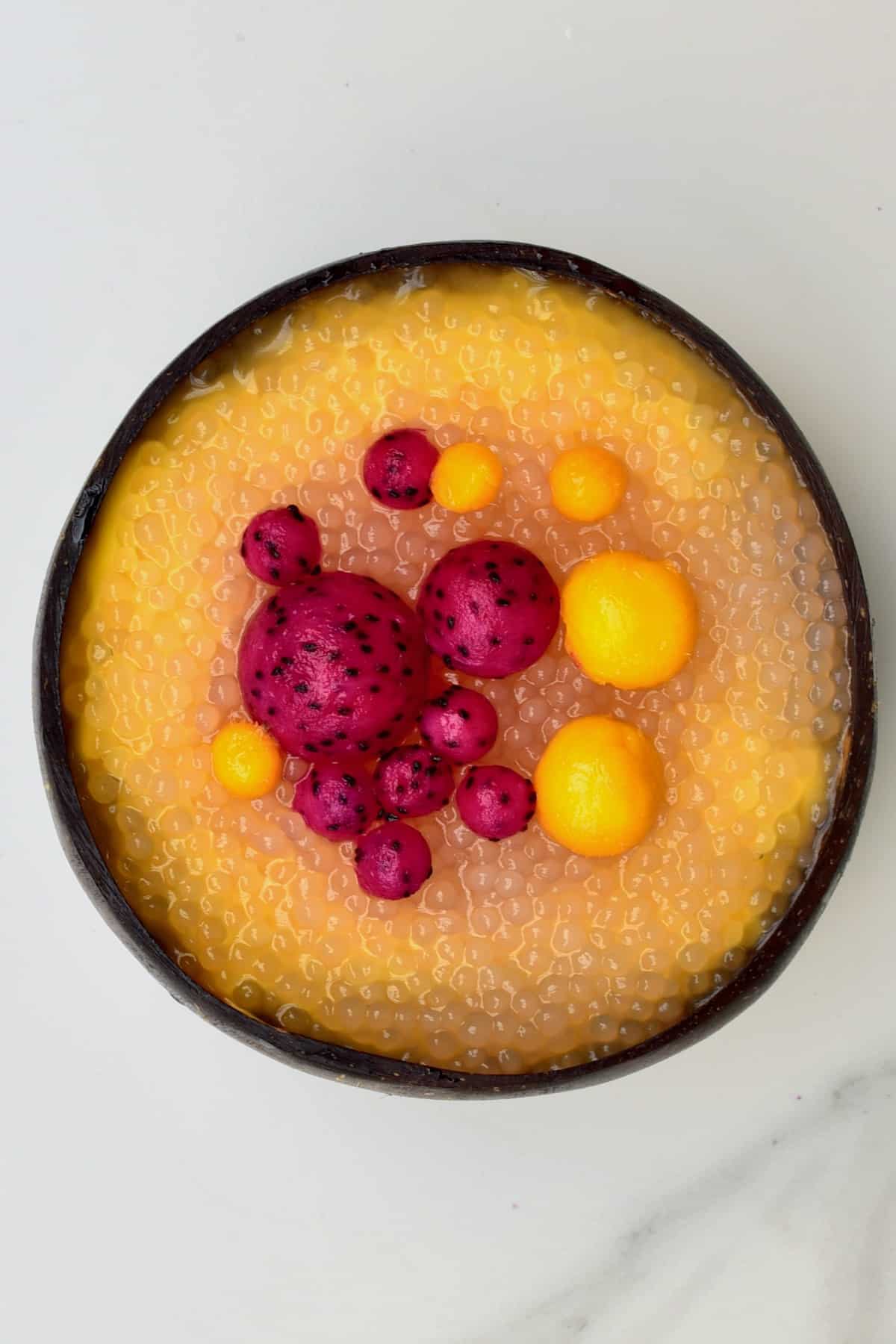
FAQs
You would have to use mini tapioca pearls that are a similar size to sago for a mango tapioca pudding. However, I don’t see a reason why not. The cooking method may differ, though. I recommend bringing your pot of water to a boil, then adding the tapioca pearls, stir well and then allow it to simmer for around 15 minutes, or until the pearls have turned completely transparent (like fish eggs/frog spawn). Then, rinse and soak the same way I have with the sago pearls.
There are several ways that you can store the cooked sago pearls, including:
In the freezer: This will help preserve the texture and flavor the best way, so is my recommended method. After rinsing and soaking the cooked pearls, then transfer them to an airtight reusable freezer bag. Spread out in a thin layer and squeeze out all the excess air and seal. Freeze for up to 4 months.
You can thaw the frozen sago in a pot of boiling water for a few minutes, then drain and use.
In the fridge: For this method, you’ll need to store the cooked pearls in water, so they don’t dry out. Store in an airtight container for 2-3 days. Drain before using.
Try to only store the cooked pearls at room temperature for up to 4 hours maximum!
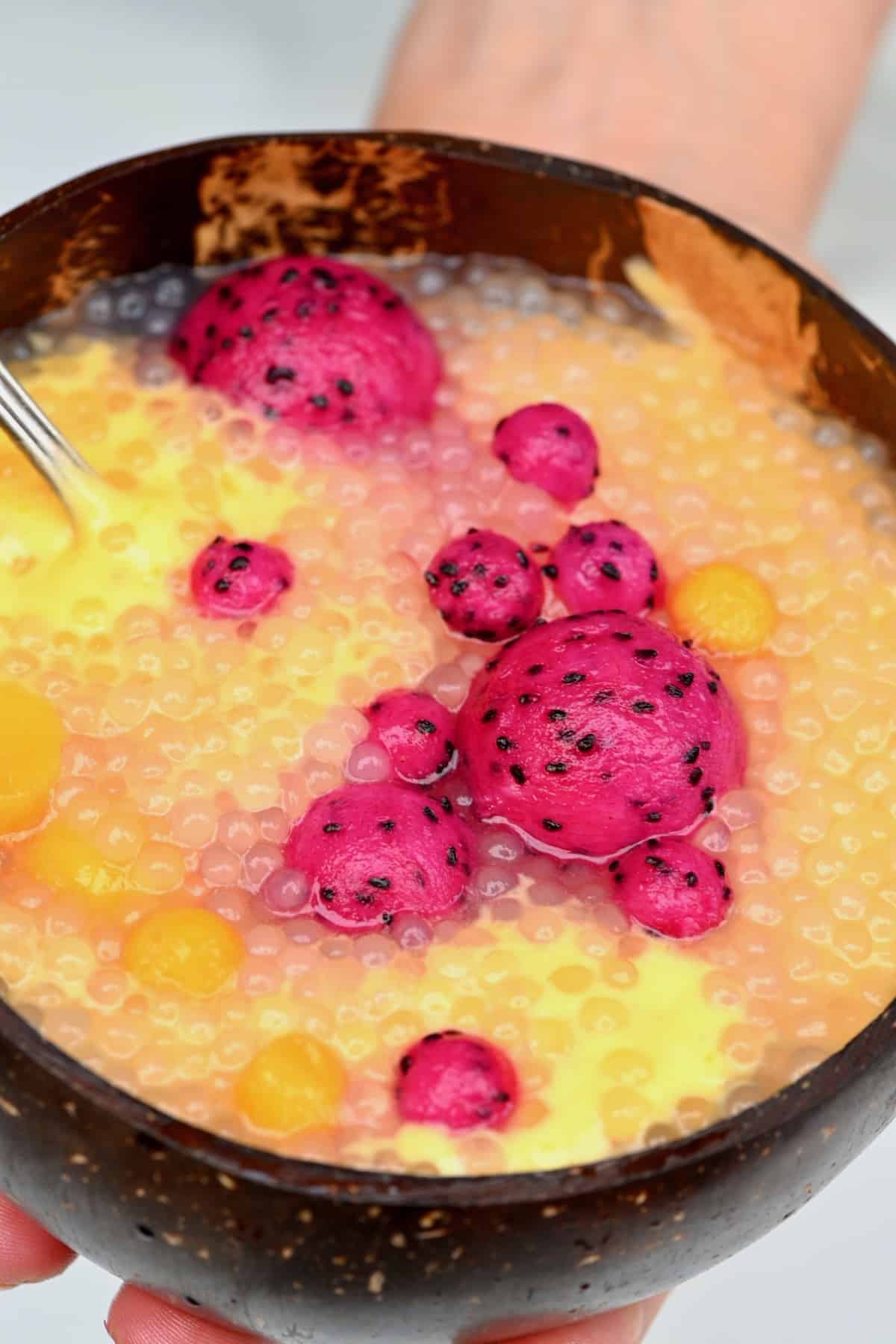
More Recipe Notes
- Save some mango for the topping: this isn’t necessary, but you may want to save some of your mango from being blended and instead keep it as an extra topping to the mango sago dessert.
- The pearl size: you may be able to get tapioca/sago pearls of different sizes. I like to use tiny ones for my preferred texture. However, feel free to use larger ones for chewier results. Just note that the cooking time will vary.
- Give the pudding time to marinate: You can enjoy the mango sago immediately after preparing it. However, if you allow the dessert some time to chill in the fridge, the flavors will have time to marinate and ‘meld’. Just give it a quick taste before serving, as the sweetness can mellow when chilled, so you may want to add a little more condensed milk.
Other Creamy Desserts and Drinks
- Vietnamese avocado shake (Sinh To Bo)
- Thai sweet sticky rice with mango
- Tropical guava smoothie
- Healthy ube blueberry milkshake
- Coconut vanilla bean creme frappuccino
- Ayran/Doogh (salty yogurt drink)
- Strawberries and cream frappuccino
If you try this creamy mango sago recipe, I’d love to hear your thoughts/questions below. Also, I’d really appreciate a recipe card rating below, and feel free to tag me in your recipe recreations on Instagram @Alphafoodie!

Mango Sago Dessert
Ingredients
- 1/4 cup small-sized uncooked sago pearls or tapioca
- 2 medium-sized ripe mangoes or tinned mango pulp
- 1.5 cup full-fat coconut milk
- 2 Tbsp sweetened condensed milk optional – or sweetened condensed coconut milk (vegan)
Toppings (optional)
- mango chunks or balls keep some from the mango
- dragonfruit balls optional
- coconut, shredded or flakes optional
Instructions
Step 1: Soak the pearls
- Technically this step is optional but highly recommended as it can cut their cooking time down by 50%! I recommend soaking the pearls in room-temp water for at least two hours at room temperature or overnight (in the fridge).
Step 2: How to cook sago pearls
- Bring a pot of water (enough to cover the pearls by several inches as they’ll expand 2-3x their size while cooking) to a boil.
- Add the sago pearls, bring to a boil once more, and then reduce the heat to a simmer and cook until the pearls are completely translucent, with a slightly brownish tint.This will take around 40-45 minutes if the pearls weren’t soaked or 15-20 minutes if they were.
Step 3: Drain and rinse the sago
- Drain the sago pearls through a colander and then rinse them well with cold water to remove excess starch.
- If the remainder of the mango sago pudding ingredients isn't prepared at this point (it only takes a couple of minutes), then you can keep the sago in cold/ice water while prepping the rest.Don’t leave cooked sago balls out at room temperature for more than 4 hours, or they can turn bad. If you know you won’t be using them for longer, then store them, in the water, in the refrigerator.
Step 4: Prepare the mango pudding
- Cut the mango (using one of these four methods). As you will blend the mango, there’s no need to make pretty cubes. You could even peel the mango and simply scoop all the flesh from the seed.Feel free to keep some to one side as a topping. I used a mini scooper/baller to create little mango ‘balls’. I did the same with some pink dragon fruit (completely optional).
- Add the mango, coconut milk, and condensed milk to your food processor or blender and blend till you achieve a smooth consistency.
- If the pudding is too thick, then add in a little more milk. If it’s not sweet enough, increase the condensed milk or add a little of your favorite liquid sweetener (like maple).
Step 5: Assemble the mango sago bowls
- Transfer the mango mixture to a bowl (or glass jars/cups) and add the sago pearls. These can be used to top the pudding or mixed into it, then top with the mango and dragonfruit balls (and optionally some shredded/flaked coconut). You could also add a few extra spoonfuls of coconut milk if preferred.For extra sweetness, you could even drizzle the top of the pudding with a bit of extra condensed milk.
How to Store Mango Sago?
- Store: Store the prepared mango sago in the fridge for up to two days, though the fresher it is, the better the results. To read about how to store the cooked sago pearls, read the FAQs.Freeze: I haven’t tried to freeze this sago dessert before as I prefer it fresh. However, freezing the prepared, combined mango sago should work (untopped). I recommend wrapping it tightly (or transferring it to single-serve airtight containers) then freeze for up to three months. Allow it to thaw overnight for an ‘instant’ dessert the following day.
Notes
- Save some mango for the topping: this isn’t necessary, but you may want to save some of your mango from being blended and instead keep it as an extra topping to the mango sago dessert.
- The pearl size: you may be able to get tapioca/sago pearls of different sizes. I like to use tiny ones for my preferred texture. However, feel free to use larger ones for chewier results. Just note that the cooking time will vary.
- Give the pudding time to marinate: you can enjoy the mango sago immediately after preparing it. However, if you allow the dessert some time to chill in the fridge, the flavors will have time to marinate and ‘meld’. Just give it a quick taste before serving, as the sweetness can mellow when chilled, so you may want to add a little more condensed milk.
Other Optional Add-ins and Variations:
- Mango pomelo sago: the original Hong Kong version of this dish included pomelo. If you live somewhere where it’s easy to source this ingredient, it’s highly recommended – it adds citrusy tang to the dessert. You can add pomelo segments or peel the skin off the segments and separate the tiny ‘pulp’ sections inside – for a citrusy treat that bursts in your mouth. If you can’t find pomelo, you could try another tart citrus, like grapefruit.
- Coconut: shredded or flakes, you can add coconut to the top of the pudding. I recommend toasting it for a slight crunch and an extra layer of flavor.
- Lime: for a touch of ‘zing’ and extra freshness, you could serve the mango sago dessert with a squeeze of fresh lime.
- Vanilla extract: feel free to add a little vanilla extract to the mango blended mixture for extra flavor. I use homemade vanilla extract and add around ½ tsp then increase, to taste.
Nutrition
Nutrition information is automatically calculated, so should only be used as an approximation.




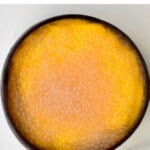
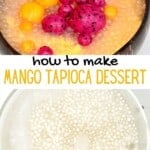



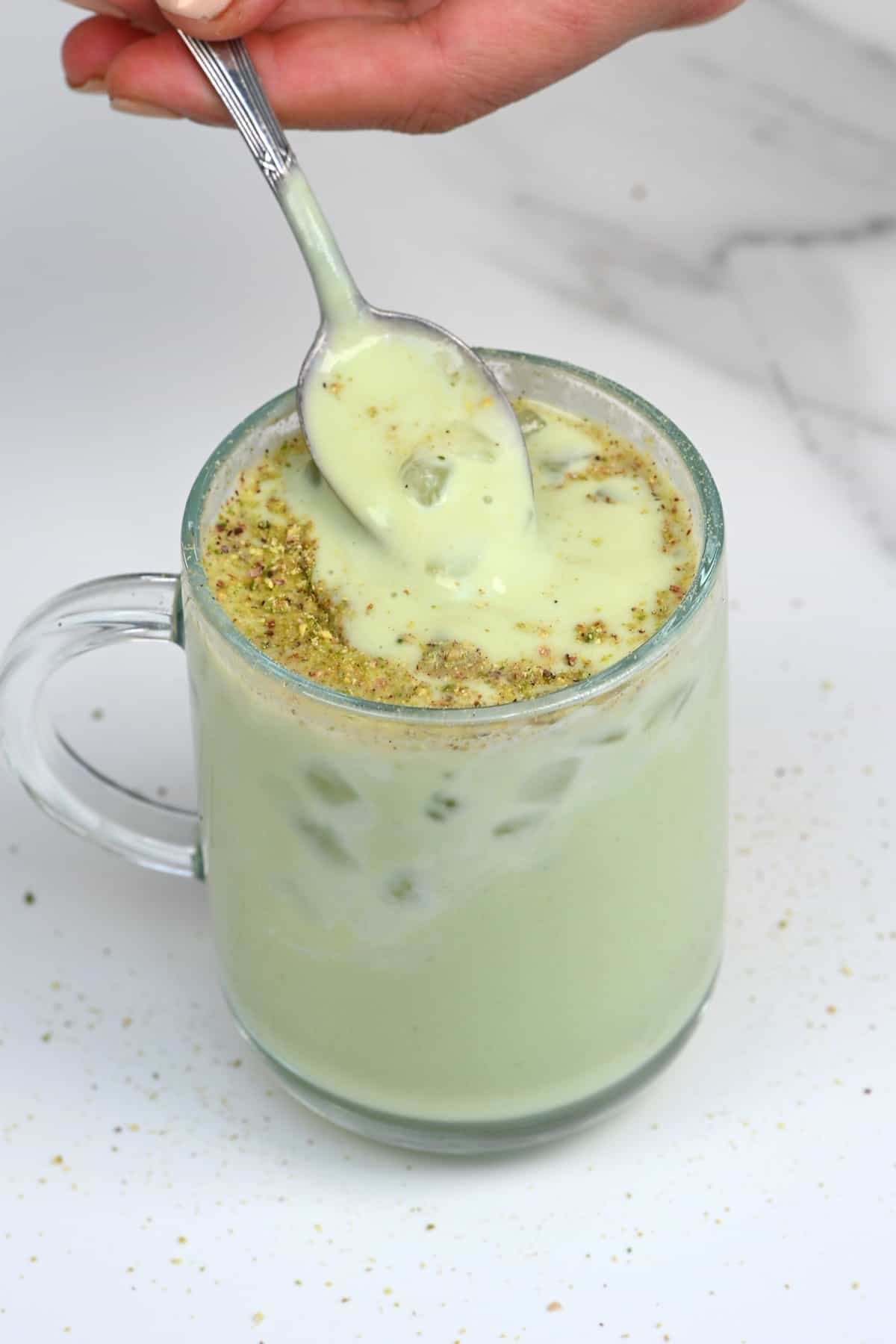
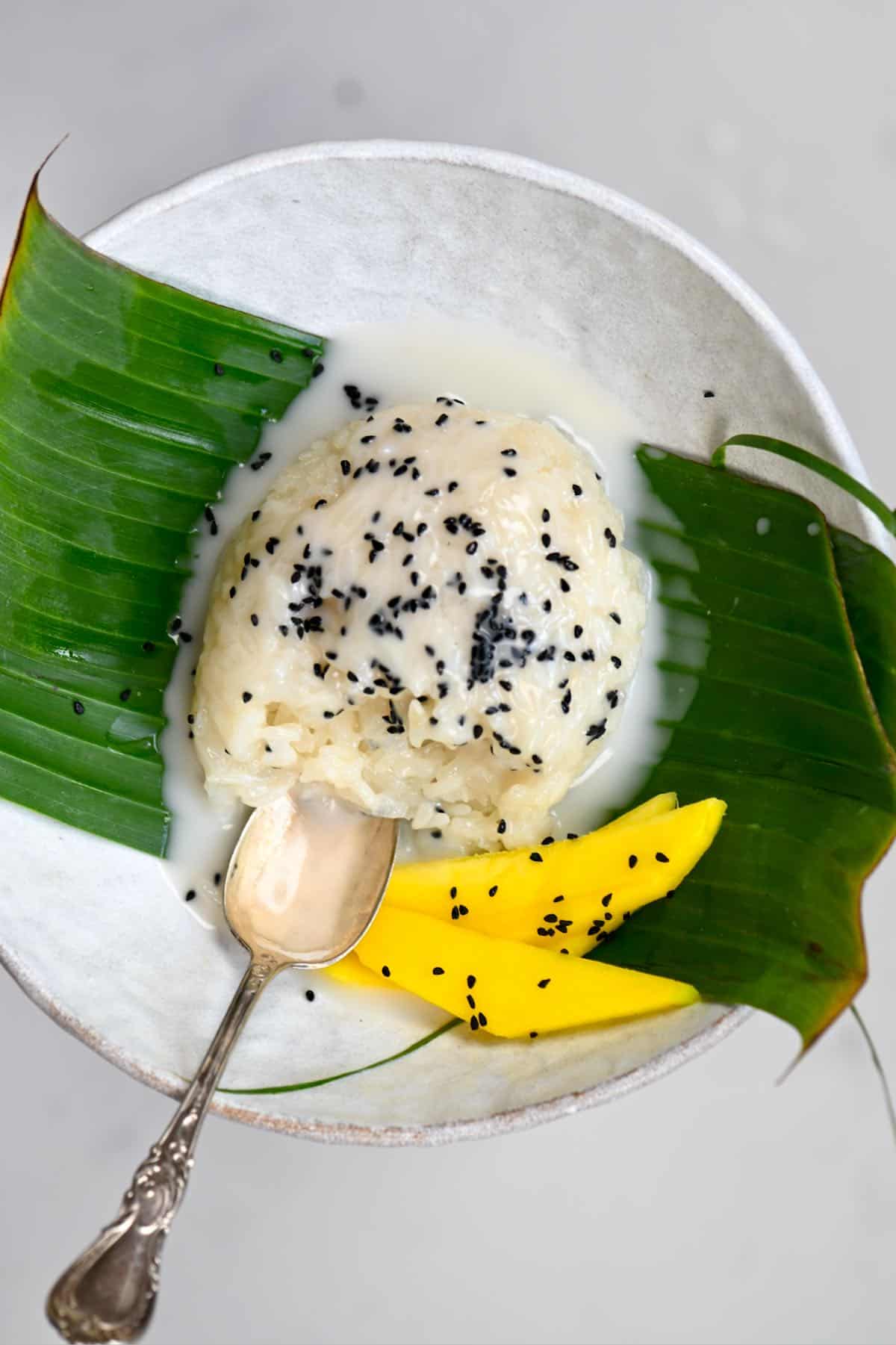
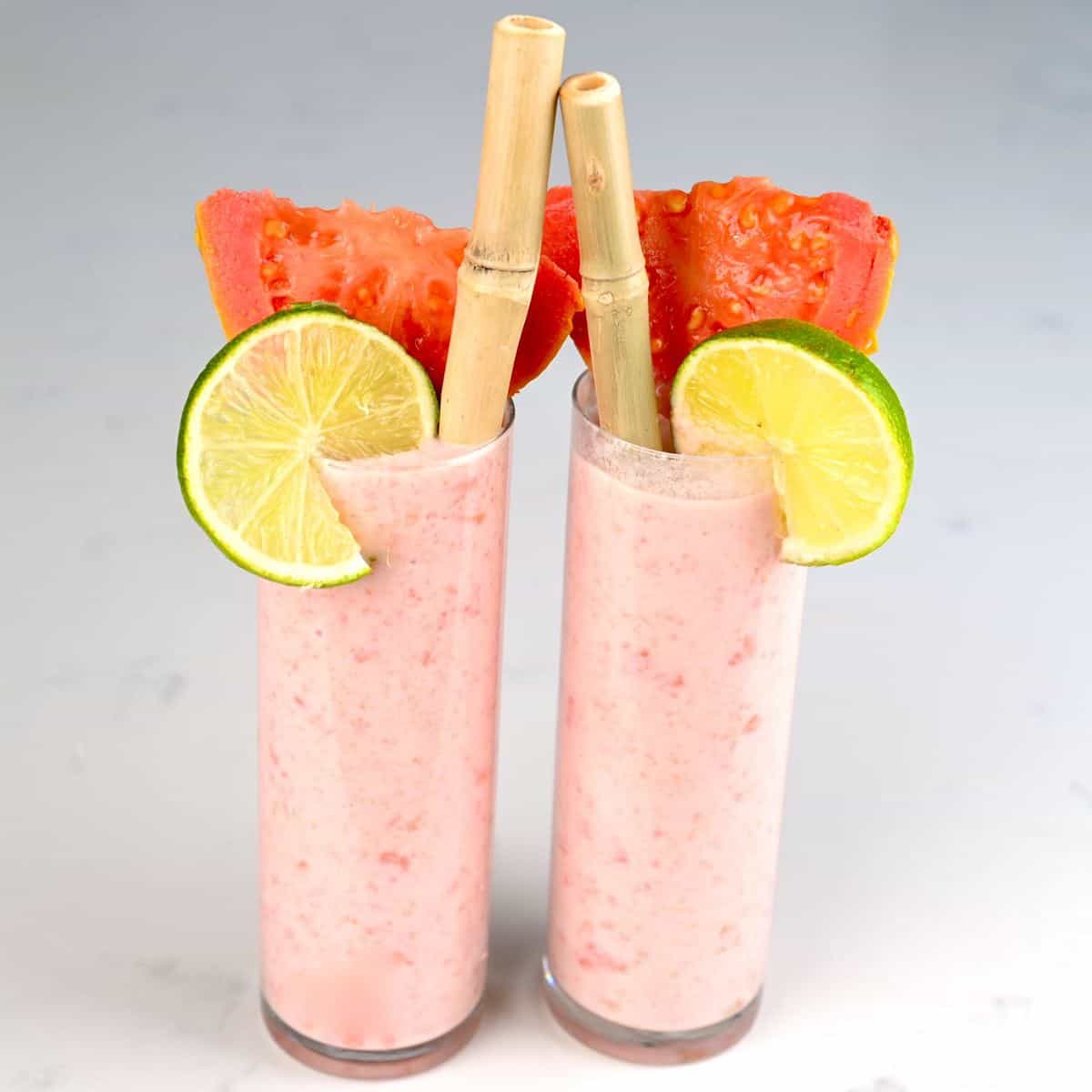









Thank you for this recipe. I accidently bought Tapioca Pearls but luckily they worked fine.
I used Mango pulp (850g from a can) & used a cup of coconut milk but my mixture turned out very thin even though I didn’t use condensed milk. I then added 4 tbsp of cornflour. The mixture somewhat improved in consistency. What did I do? Many thanks